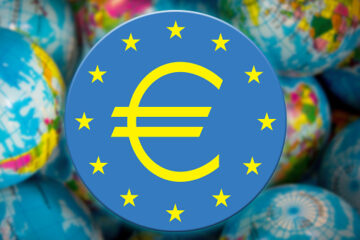The big reason for the stock market drop last week was the higher-than-hoped tariffs unveiled by President Trump on April 2. The “Liberation Day” tariffs revealed ranged from a baseline tariff of 10% to 54% tariffs on China.
Market participants hoped negotiations ahead of the President’s Liberation Day announcement would lead to a more tempered approach to import taxes. Since that didn’t happen, investors were forced to revamp models to include expectations for higher inflation and slower economic growth, which are the enemy of corporate profits.
The downdraft was fast and sharp. The S&P 500 dropped 10% following the announcement, sending investors scurrying for safety in Treasury Bonds, including the 10-year note, which saw its yield drop below 4% from 4.3% only days earlier.
Related: Surprising China news sends stock market reeling
The stock market sell-off likely didn’t go unnoticed by the White House. Over the weekend, the administration went on a media frenzy to pitch its case for tariffs to the American people.
However, in those discussions, there was no acknowledgment that President Trump is open to negotiating lower tariffs. Instead, Commerce Secretary Howard Lutnick and trade adviser Peter Navarro took a mostly hard-line position on tariffs.
💵💰Don’t miss the move: Subscribe to TheStreet’s free daily newsletter 💰💵
Treasury Secretary Scott Bessent, however, has come across as a notable ‘voice of reason’ amid the tariff tussle.
Bessent, a long-time stock market veteran trained under billionaire hedge fund manager Stanley Druckenmiller, came across as more balanced in his conversations, and his most recent comments are encouraging to investors.
Scott Bessent, United States Secretary of the Treasury, has offered encouraging words on the tariff dispute.
The stock market tumbles amid rising risks of recession
Fed Chairman Jerome Powell made a big mistake arguing inflation was transitory in 2021. Inflation surged above 8% in 2022, forcing the Federal Reserve to adopt the most restrictive and hawkish monetary policy of interest rate hikes since Fed Chair Paul Volcker battled inflation in the early 1980s.
Related: Stanley Druckenmiller sends curt 7-word response to tariff war
Higher interest rates successfully lowered inflation below 3%, but they also caused cracks in the jobs market. Lay-offs became increasingly common last year, and as a result, unemployment has climbed to 4.2% from 3.5% in 2023.
The uptick in joblessness led to Fed interest rate cuts last September, November, and December, but, unfortunately, inflation has trended higher, and the jobs market has yet to improve.
Consumer Price Index inflation was 2.8% in February, up from 2.4% in September, and 275,000 Americans were laid off in March, according to Challenger, Gray, & Christmas, 205% more than one year ago.
The situation has put the Fed’s rate cut plans on pause, removing a key catalyst that had helped the S&P 500 rally 24% in 2024. With a less friendly Fed and mounting evidence of a slowing economy, stocks were already struggling before Trump’s tariffs were announced.
Nevertheless, the tariffs proposed do little to reduce the risk of an economy heading toward stagflation or, worse, recession. While tariffs may help drive manufacturing back to the United States, they’re also inflationary, given that importers must pay the tax on everything from clothing to cars.
Scott Bessent says Donald Trump is prepared to negotiate with countries on tariffs, stocks surge
The White House’s message over the weekend suggested an indifference to the stock markets’ machinations rather than an interest in stemming the bleeding by agreeing to tariff relief.
Related: BlackRock CEO resets recession forecast for 2025
As a result, Americans and businesses were left with significant uncertainty amid declining portfolio balances, which isn’t great for consumer confidence and spending.
On April 8, Secretary Bessent struck a more encouraging tone, suggesting that Donald Trump has received many calls from global leaders and is willing to work with them to ink deals that could reduce the tariff burden.
“I think you are going to see some very large countries with large trade deficits come forward very quickly,” said Bessent on CNBC. “If they come to the table with solid proposals, I think we can end up with some good deals.”
The Treasury Secretary said that Japan would be first-up to have discussions with the President over tariff relief. The reciprocal tariffs placed on Japan on Liberation Day were 24%. Bessent and United States Trade Representative Jamieson Greer are expected to spearhead those negotiations.
“The good news is that a cap on tariffs has been set, and now the hard work of making deals and reducing the tariff burden has begun,” wrote long-time investor James DePorre on TheStreet Pro.
More Economic Analysis:
Wall Street overhauls S&P 500 price targets as tariff selloff acceleratesInflation would like a word, pleaseStocks could bounce, but big bank earnings hold the cards
More negotiations with additional countries are likely.
“I think we’re up to 70 countries contacted the White House for how to come to negotiate,” said Bessent.
The bad news? China isn’t among them. China’s leadership unveiled 34% retaliatory tariffs, matching Trump’s reciprocal tariff announced on April 2. China’s Ministry of Commerce said on Tuesday it would “fight to the end.”
The retaliation led President Trump to respond with an additional 50% tariff, bringing total tariffs on China to 104% beginning on April 9.
“I think it was a big mistake, this Chinese escalation,” said Bessent. “They’re playing with a pair of twos. We export one-fifth of what they export to us, so that’s a losing hand for them.”
Related: Veteran fund manager unveils eye-popping S&P 500 forecast


